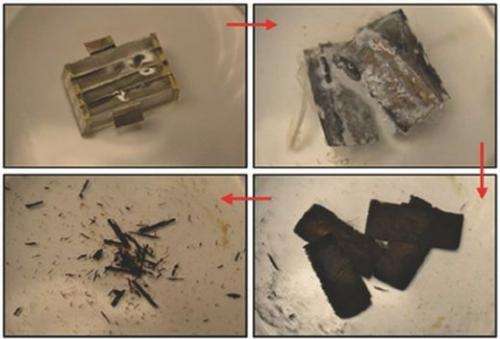March 27, 2014 weblog
Battery dissolves in water, holds promise for biomedical implants

(Phys.org) —Biomedical engineers are working on drug delivery devices that can be implanted. Now scientists have come up with a way to power such devices inside the body. Their design is capable of breaking up and dissolving in the body.
A new battery developed by a team at University of Illinois, Urbana-Champaign, was recently reported in Nature which also carried an illustration of a four-cell battery made of biodegradable materials that completely dissolves in water. The article focused on the work of scientists who have now created a fully biodegradable battery designed to dissolve in the body after doing its work as power source for devices embedded in tissue A paper that describes their work was published earlier this month in the journal Advanced Materials. The article, "Materials, Designs, and Operational Characteristics for Fully Biodegradable Primary Batteries," is authored by Lan Yin, Xian Huang Hangxun Xu, Yanfeng Zhang, Jasper Lam, Jianjun Cheng and John A. Rogers. The latter is known for his research on nano and molecular scale fabrication and materials and patterning techniques for unusual electronic and photonic devices.
The article in Nature:discussed what they use, nodes of magnesium foil and cathodes of iron, molybdenum or tungsten ,all of which are metals that slowly dissolve in the body. Their ions are biocompatible in low concentrations. "The electrolyte between the two electrodes is a phosphate-buffered saline solution, and the whole system is packed up in a biodegradable polymer known as a polyanhydride."
Interestingly, Jeffrey Borenstein, a biomedical engineer at Cambridge, Mass.-based Charles Stark Draper Laboratory, in 2009 wrote about the implantable drug-delivery device he and colleagues were developing and he was looking ahead to drug-delivery systems in years to come. While the "bedrock of modern medicine" has been an age-old technology, the pill, researchers have searched for better ways to deliver drugs, he wrote. "The ideal method," he said, "would administer the right dose to the exact area being treated, whether it's an arthritic knee or a tumor in the lungs."
This month, commenting on the new battery research, Borenstein told Nature that "This is a really major advance." Until recently, he said, there has not been a lot of progress in this area.
Quoted in Nature, Rogers said, "Almost all of the key building blocks are now available" to produce self-powered, biodegradable implants. All versions can maintain a steady output for more than a day, but the team aims to improve the batteries' power per unit weight, or power density.
More information: Yin, L., Huang, X., Xu, H., Zhang, Y., Lam, J., Cheng, J. and Rogers, J. A. (2014), Materials, Designs, and Operational Characteristics for Fully Biodegradable Primary Batteries. Adv. Mater.. DOI: 10.1002/adma.201306304
Abstract
Biodegradable electronics represent an emerging class of technology with potential to provide advanced semiconductor functionality in temporary biomedical implants. This work reported a biodegradable primary battery as a potential power source for these systems, which uses biodegradable metal foils and polyanhydride packages. Monolithically integrating cells yields battery packs with sufficient power to operate conventional light emitting diodes and radio transmitters.
Journal information: Advanced Materials , Nature
© 2014 Phys.org



















